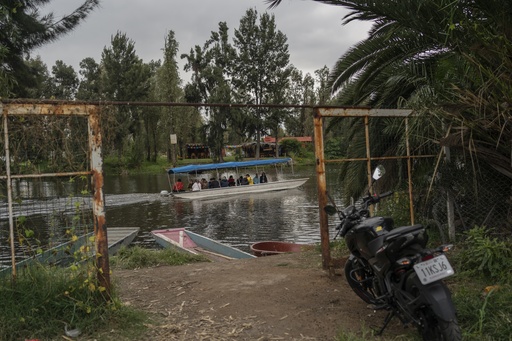
MEXICO CITY — Cassandra Garduño squinted against the bright sunlight, her pink boots marked with dirt as she observed her family’s chinampa, one of the ancient islands originally constructed by the Aztecs using rich mud from a lake that eventually dried up to form Mexico City.
For centuries, these islands have been a source of food for the local population, yet they are increasingly threatened by urban expansion. The crops produced here often fail to yield substantial financial returns, leading many families to abandon this traditional form of agriculture in favor of selling or leasing their land for more profitable ventures like soccer fields.
“Farming isn’t a priority for people anymore,” Garduño remarked. “There’s a lack of interest in production, and the demand for our products has diminished.”
Despite this decline, some farmers like Garduño are uniting to safeguard and revitalize the traditional practices associated with chinampas.
“None of this can continue without the human touch, the labor of those who have cultivated these lands for generations,” she stated on a recent day, as the scent of nearby celery wafted through the air.
Nestled in the southern Xochimilco borough of Mexico City, these gardens connected by canals are made from layers of dredged soil, secured by slender ahuejotes, a native willow species planted along their borders. Over 2,500 acres of this protected land belong to local chinamperos, the farmers who maintain these unique islands.
Garduño recalls her childhood days spent gazing through her grandparents’ window at the family chinampa, watching the graceful movement of canoes gliding through the canals. Even then, she recognized the slowing decline of the chinampas due to urban pressures and the waning interest from some farmers.
Following her grandfather’s death in 2010 and her uncles’ indifference to continuing the farming legacy, she resolved to learn the ancient techniques and preserve the customs passed down through her family. Initially met with skepticism, Garduño purchased a plot of land from a friend’s uncle in 2020, where she now cultivates a variety of crops, including sunflowers, eggplant, and the traditional Mexican marigold known as “cempasuchil.”
At just 32 years old, Garduño has become a vital member of Chinampa Refuge, a collective organized by the National Autonomous University of Mexico. Together with her colleagues, she advocates for the conservation of chinampas, employing time-honored agricultural methods while adopting new marketing strategies to compete with cheaper produce from large-scale farms. This includes a special label, Etiqueta Chinampera, which informs customers that the produce is derived from chinampa farming and highlights aspects such as environmental quality and biodiversity.
“Education is key for bringing about change to future generations,” Garduño emphasized. “It’s vital to discuss our history and efforts to maintain this tradition, along with why it’s essential.”
Luis Zambrano, an ecologist at the National Autonomous University of Mexico, who has dedicated decades to studying Xochimilco, remarked on the sustainability of these farming practices. The fertile land continues to thrive, benefiting from the nearby lake, allowing for three to five vegetable harvests each year without the need for fertilizers or pesticides.
Additionally, Xochimilco’s ecosystem provides significant benefits to Mexico City, supporting various species of birds and fish, while the expansive canals help moderate the urban heat.
However, during weekends, the sight of soccer players paddling to their games in jerseys and cleats has become more frequent than farmers at work. The conversion of chinampa land into soccer fields has seen a remarkable rise over the last few years, according to Zambrano.
Many locals in Xochimilco are hesitant to speak openly about transforming their chinampas into soccer arenas. One landowner, who chose to remain anonymous due to fears of backlash, explained that sustaining chinampas requires considerable effort and investment but yields limited financial return compared to other ventures. Consequently, she has diversified her land’s use by opening a weekend soccer field, a food stall, and offering kayaking tours for visiting tourists.
“Successful farming could bring in between $5,000 to $10,000 a year,” Garduño noted. “Whereas in the tourism sector, that income could be generated in just a couple of weekends.”
However, the shift towards non-agricultural uses has ecological consequences. While traditional farming methods eschew chemical fertilizers and pesticides, maintaining soccer fields involves a different approach.
“It might not seem harmful due to the absence of construction, but the proliferation of chemicals and the pollution produced from those fields is quite significant,” said Zambrano.
Chinampas are recognized as crucial elements that contributed to Mexico City’s historic center and Xochimilco being designated as a UNESCO World Heritage site. Protection and conservation of these areas fall under the jurisdiction of federal, state, and local authorities. Carlos Vasquez, head of the Natural Protected Areas at Mexico City’s Environmental Department, confirmed that there are ongoing efforts to regulate the proliferation of soccer fields.
“Many of these changes counteract the conservation of vital ecosystems,” he explained. “We are actively developing regulations to address these activities.”
After a long day of labor under the sun, Garduño and fellow farmers gather beneath her makeshift hut for a communal meal of chicken and tortillas, discussing their day’s work and what remains on their agendas.
Juan Ávalos, 63, and his brother Salvador Gonzalez Ávalos, 55, have dedicated their lives to maintaining chinampas, overseeing several plots in Xochimilco’s San Gregorio neighborhood. After much persuasion from Garduño, the brothers joined the Chinampa Refuge a year ago to embrace a more holistic farming approach.
Salvador stressed that this approach serves as a constant reminder of his family’s heritage and the importance of preserving these ancient practices for future generations.
“There’s a responsibility we hold as grandparents to pass down this connection to the land,” he said. “It’s essential that they appreciate this earth.”
